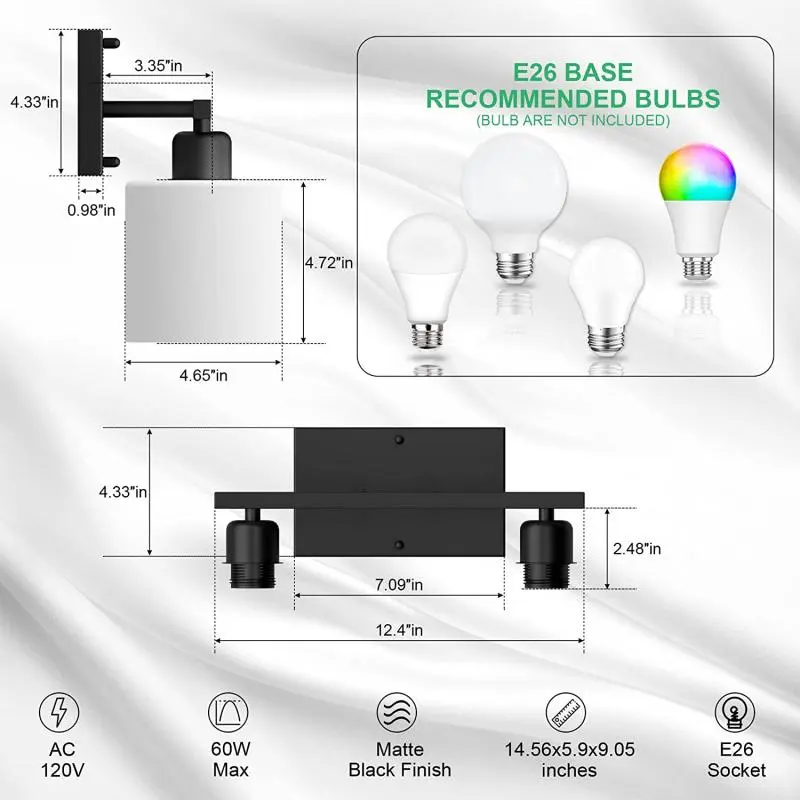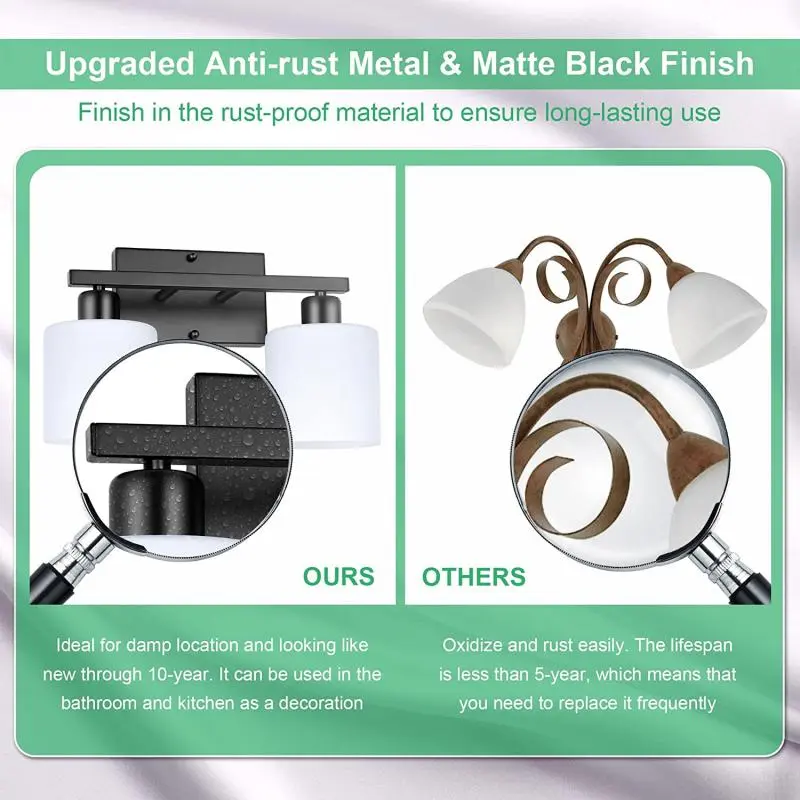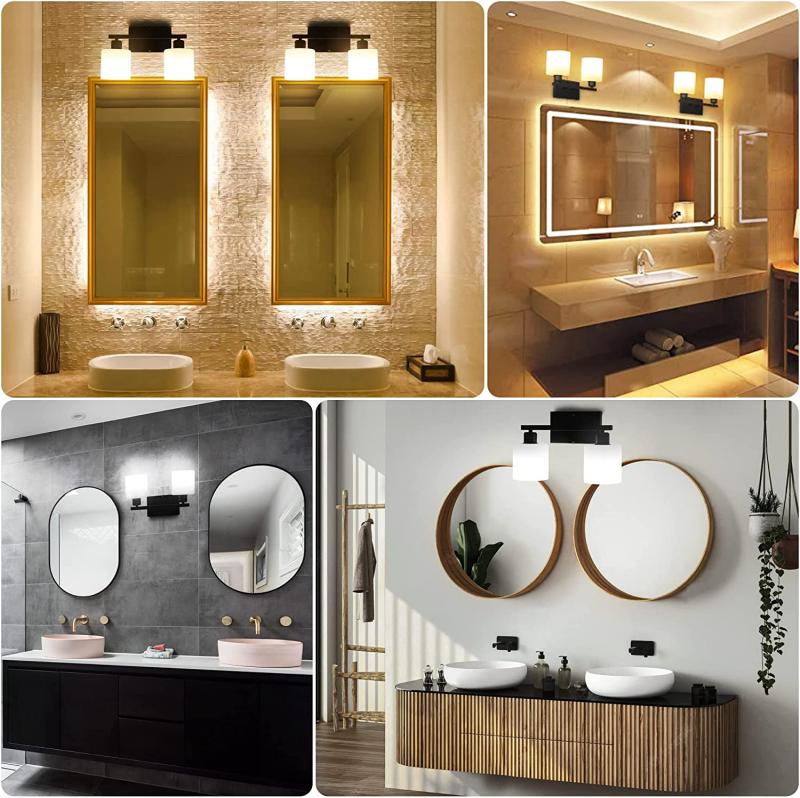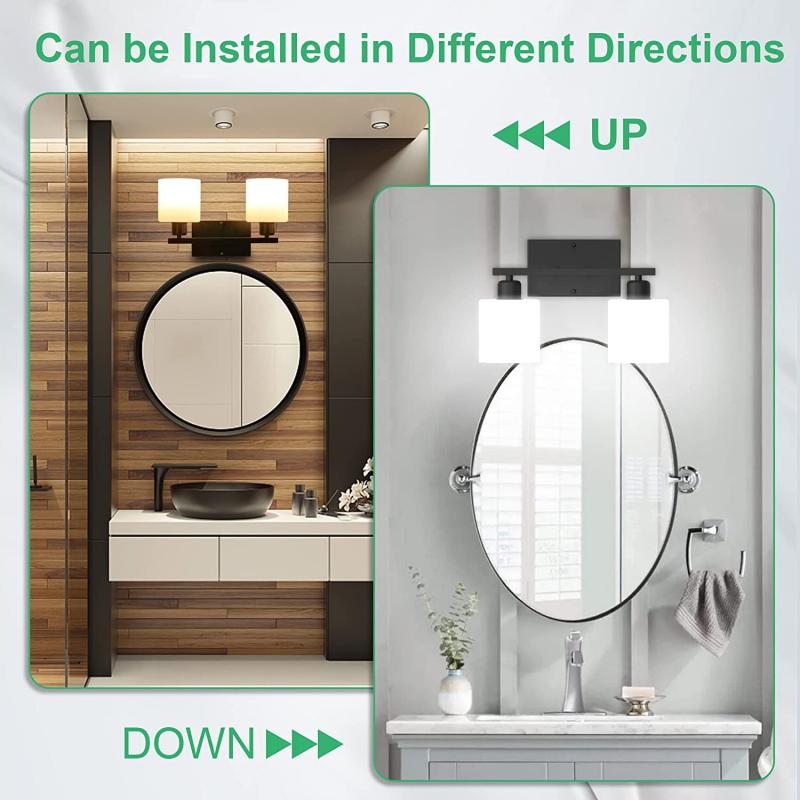Should a vanity wall light be centered over the sink or mirror?
In modern living, the dressing table is not only a crucial area for applying makeup, skincare, and grooming, but also a central element in the bathroom or bedroom lighting design. A proper vanity wall light placement not only impacts facial illumination uniformity, color accuracy, and visual comfort, but also influences the overall ambiance and aesthetics of the space.
This article addresses a frequently asked consumer question: Should a vanity wall light be centered over the sink or mirror? This article provides a detailed and professional analysis of various aspects, including its function, optical design principles, and placement, to provide guidance for a sound layout.

Vanity wall light: What is its purpose?
Vanity wall lights are a type of localized functional lighting. Compared to ceiling lights or mirror lights, they focus more on facial illumination and detail rendering. In professional design, the main functions of vanity wall lights include:
1. Uniform facial illumination
Vanity wall lights directly illuminate the face with a localized light source, illuminating it from the front or sides, effectively reducing shadows. This is particularly crucial for applying makeup, shaving, and skincare. For example, using overhead lighting alone can create shadows under the eyes and along the sides of the nose, affecting the accuracy of makeup application. However, strategically placed vanity wall lights can evenly distribute light and highlight natural facial contours.
2. Light Color Optimization and Color Reproduction
Vanity wall lights typically utilize light sources with a high color rendering index (CRI>80) to ensure that skin tones and cosmetic colors are faithfully rendered. The CRI is an important indicator of the color fidelity of a light source. A high CRI reduces color shift, resulting in more accurate makeup and skincare results. For example, lipstick, blush, and eyeshadow may appear off-color under low CRI light sources, while high CRI sources maximize color reproduction.
3. Visual Enhancement of the Space
Beyond functional lighting, vanity wall lights can enhance the sense of depth and three-dimensionality in a space. Localized accent lights can create a bright and spacious visual effect, making the dressing area the visual centerpiece of the space while harmonizing with the overall lighting environment, enhancing overall aesthetics and comfort.
4. Auxiliary Ceiling Light Function
In a bathroom or bedroom, ceiling lights primarily provide ambient lighting, while vanity wall lights provide supplementary, localized illumination, creating a layered effect. This focused light source allows for clearer facial contours and details, enabling more precise makeup, shaving, and skincare applications.

Vanity Wall Light: What are the Optical Design Principles?
Scientific optical design is the core of the vanity wall light's functionality. Whether mounted centrally or on either side of the mirror, fundamental principles such as light uniformity, color reproduction, and illumination angle must be adhered to.
1. Light Uniformity
• Facial lighting uniformity is the primary requirement for vanity wall light design. Spotlights that are too bright or too dim can result in bright or shadowed areas on the face, compromising makeup application accuracy.
• A single centrally located light can easily create shadows on the upper and lower sides of the face or on the nose. Symmetrical installation on both sides balances light and reduces facial shadows.
• In advanced designs, combined lighting above and below the mirror can further optimize uniformity, ensuring full coverage while also taking into account the mirror's reflections.
2. Light Color Selection and Color Rendering Index
• Vanity wall lights typically have a color temperature between 3000K and 5000K, covering warm, neutral, and cool white light. Different light colors affect the user's visual perception of skin tone and makeup.
• Wall lights with a color rendering index (CRI) above 80 accurately represent facial and cosmetic colors, which is a key indicator for ensuring accurate makeup and skincare application.
• Harmonizing light color with the overall lighting environment can reduce visual fatigue and enhance comfort. For example, in an environment with a neutral 4000K overhead light, choosing a vanity wall light with the same color temperature or an adjustable color temperature design can avoid color clashes.
3. Lighting Angle and Light and Shadow Control
• Light should illuminate the face from slightly above eye level to avoid shadows on the nose or eyes from downward illumination.
• Adjustable wall lights can adjust the light direction based on the user's height, mirror height, and usage habits, providing an even and soft facial illumination.
• Light diffusion designs (such as diffusers and diffusers) can reduce direct glare and improve visual comfort.

Which vanity wall light placement is best?
Vanity wall light placement is a key factor influencing lighting effects, user experience, and the aesthetics of the space. Key placement options include:
1. Single light placement in the center of the mirror
• Advantages: Simple structure, easy installation, and suitable for small dressing tables.
• Disadvantages: Concentrated light illuminates the face from the center, which can easily create shadows above and below or to the left and right, making it difficult to see makeup details.
• Suitable scenarios: A simple solution for small dressing tables or when auxiliary light sources are insufficient, but not suitable for those who require detailed makeup or skincare.
2. Symmetrical placement on both sides
• Method: Install the vanity wall light at equal height on both sides of the mirror.
• Advantages: Balanced facial lighting, reduced shadows, and improved makeup and skincare application precision; soft light and high visual comfort.
• Note: The installation height should be level with or slightly above the top edge of the mirror to ensure even light coverage from the front and sides.
Conclusion: This is the most recommended solution for professional design, especially for medium-to-large vanities and high-precision makeup applications.
3. Combined Above-and-Below Mirror Lighting
• Method: Install wall sconces above and below the mirror.
• Advantages: The combination of upper and lower light sources reduces shadows, provides even facial illumination, and is suitable for large mirrors or wide vanities; it also enhances the sense of spatial depth.
• Precautions: Under-mirror lighting must avoid direct sunlight into the eyes and be waterproof and moisture-resistant.
Conclusion: Suitable for high-end bathroom designs or multi-functional vanities, providing optimal lighting uniformity.
Vanity Wall Light Installation Above the Sink: What are the Advantages and Disadvantages?
Many consumers believe that vanity wall lights should be located directly above the sink. The advantages and disadvantages of this are as follows:
1. Advantages
• Light directly above the sink illuminates the washing area, creating a brighter reflection on the water surface.
• The installation location is clear and installation is simple.
2. Disadvantages
• Vertical light exposure can easily create shadows around the nose and eyes.
• If the intensity of a single light source is insufficient, the overall facial illumination will be uneven. • This makes it difficult to apply makeup or skincare products with delicate movements.
3. General Recommendations
The vanity wall light should not be positioned solely in the center of the sink. It should also be positioned around the center or sides of the mirror. Incorporating optical design principles, a symmetrical arrangement of light on both sides or a combination of above and below the mirror should be employed to ensure even facial illumination and comfortable use.

Vanity Wall Light: Safety Considerations
Vanity wall lights, especially in bathrooms, require strict safety considerations:
1. Waterproof and Moisture-Proof Design
• It is recommended to select a waterproof rating of IP44 or above to prevent moisture intrusion.
• The lamp body material should be moisture-proof and mildew-resistant, and the internal circuitry should be sealed.
2. Electrical Safety
• Vanity wall lights with a low-voltage power supply (12V or 24V) or a leakage protection device are safer.
• The lamp should be installed away from direct splashing water, and the wiring should be properly laid out.
3. Anti-Glare Design
• Vanity wall lights should be equipped with a diffuser or light diffuser to prevent direct glare and visual fatigue. • Soft, even light is ideal for applying makeup, shaving, and skincare.
How do you choose the color temperature of a vanity wall light? — Huari Lighting's advice
The color temperature of a vanity wall light directly impacts facial skin tone and visual comfort:
• 3000K warm light: Soft, warm, and comfortable light, but slightly poor color reproduction for makeup applications.
• 4000K neutral light: True color reproduction and balanced lighting, suitable for daily makeup and skincare applications.
• 5000K cool white light: Bright, clear light for precise detail observation, but with a cooler visual experience.
It's recommended to choose a dimmable or color-temperature-adjustable design to accommodate different usage scenarios and lighting environments, meeting varying lighting needs in the morning, daytime, or evening.
Should a vanity wall light be mounted above the sink or mirror?
— A vanity wall light shouldn't simply be placed above the sink or mirror.
Professional layout options include:
1. Symmetrical installation on both sides: Ensures balanced lighting on the face, reduces shadows, and improves the accuracy of makeup and skincare applications.
2. Combination above- and below-the-mirror installation: Suitable for large mirrors or high-end design solutions, enhancing light uniformity and creating a sense of spatial depth.
3. Color Temperature Selection and Dimming Design: Choose a color temperature between 3000K and 5000K based on your needs, and combine it with dimming functionality to achieve a balance of comfort and precision.
Scientific placement of vanity wall lights not only enhances facial lighting but also improves the overall visual experience of the space, making it a key principle in modern bathroom and bedroom dressing area lighting design.
How does Huari ensure long-term cooperation with buyers?
Huari Lighting focuses on reliability, quality, and cost-effectiveness. We supply international wholesalers, retailers, and brands with high-quality LED products, competitive pricing, and flexible bulk order options. OEM/ODM projects and promotional discounts strengthen business partnerships.
With ISO-certified production and CE/RoHS/ERP-approved products, buyers can trust us for a consistent supply of night lights, panel lamps, and vanity lights. Our factory capacity allows for long-term, scalable collaboration with global partners.
